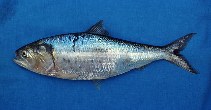| Family: |
Clupeidae (Herrings, shads, sardines, menhadens) |
| Max. size: |
31.2 cm TL (male/unsexed) |
| Environment: |
pelagic-neritic; marine; depth range 0 - 50 m |
| Distribution: |
Southwest Pacific: Peru (Puerto Pizarro in Gulf of Guayaquil to Callao and Pisco Bay; presumably to border with Chile, but no records) and Chile (whole coast south to Talcahuano). |
| Diagnosis: |
Dorsal spines (total): 0-0; Anal spines: 0-0; Anal soft rays: 12-15. Scutes present along back (before dorsal fin) as well as along belly. Upper jaw with median notch. Gill rakers fine and slender, about 130 to 150 in lower limb. Anal fin short, well behind last dorsal fin ray. Scales with pectinated hind border. A dark spot behind gill cover and up to 4 series of vertically oval spots along flank. |
| Biology: |
Occurs in coastal waters, forming large schools. Feeds by filtering phytoplankton (diatoms) and zooplankton (especially copepods), but will also take small fishes and crustaceans. Breeds in spring (Chile), depositing its eggs in coastal waters on sand, to which the sticky eggs cling, the larvae rising and joining the surface plankton on hatching. Marketed fresh, frozen, or canned. |
| IUCN Red List Status: |
Data deficient (DD); Date assessed: 13 November 2019 Ref. (130435)
|
| Threat to humans: |
harmless |
Source and more info: www.fishbase.org. For personal, classroom, and other internal use only. Not for publication.
